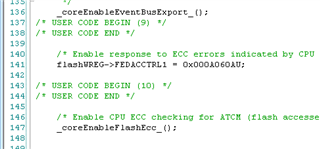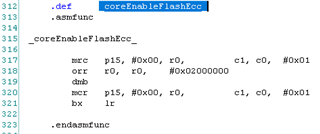Other Parts Discussed in Thread: HALCOGEN
We have a project using CCS v6 and ARM Compiler Tools 5.1.6 that we are upgrading to a different hardware platform (same processor) and we are also updating to CCS 10.1 and ARM Compiler Tools v20.2.1 (which we've used successfully in another similar project).
The project saves some special information in specific flash addresses. This is controlled using a section in the cmd linker file and a pragma to define a constant to be allocated to that section. This has worked successfully for those other previous projects.
For this new project for some odd reason we are unable to read a part of the data in that constant:


When the software attempts to read these addresses it will crash.
We can assert that the hardware is functioning correctly. We have flashed the previous project code and it seems to work. The compiler tools seem to not be a factor as rolling back to the previous compiler yielded the same result. There hasn't been any changes to the command linker file or the constant symbol definition.
Do you have any pointers as to why we are unable to access this memory?











